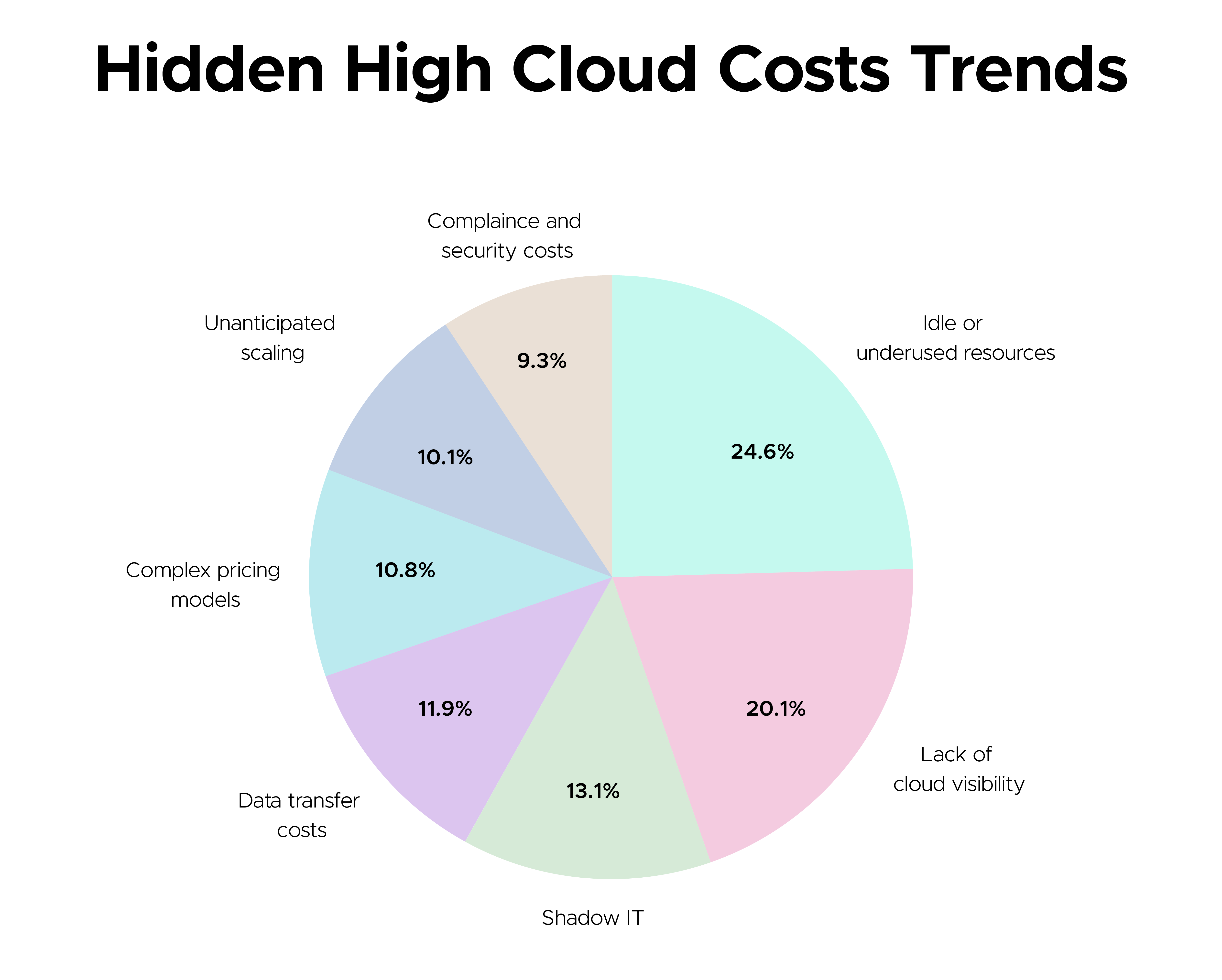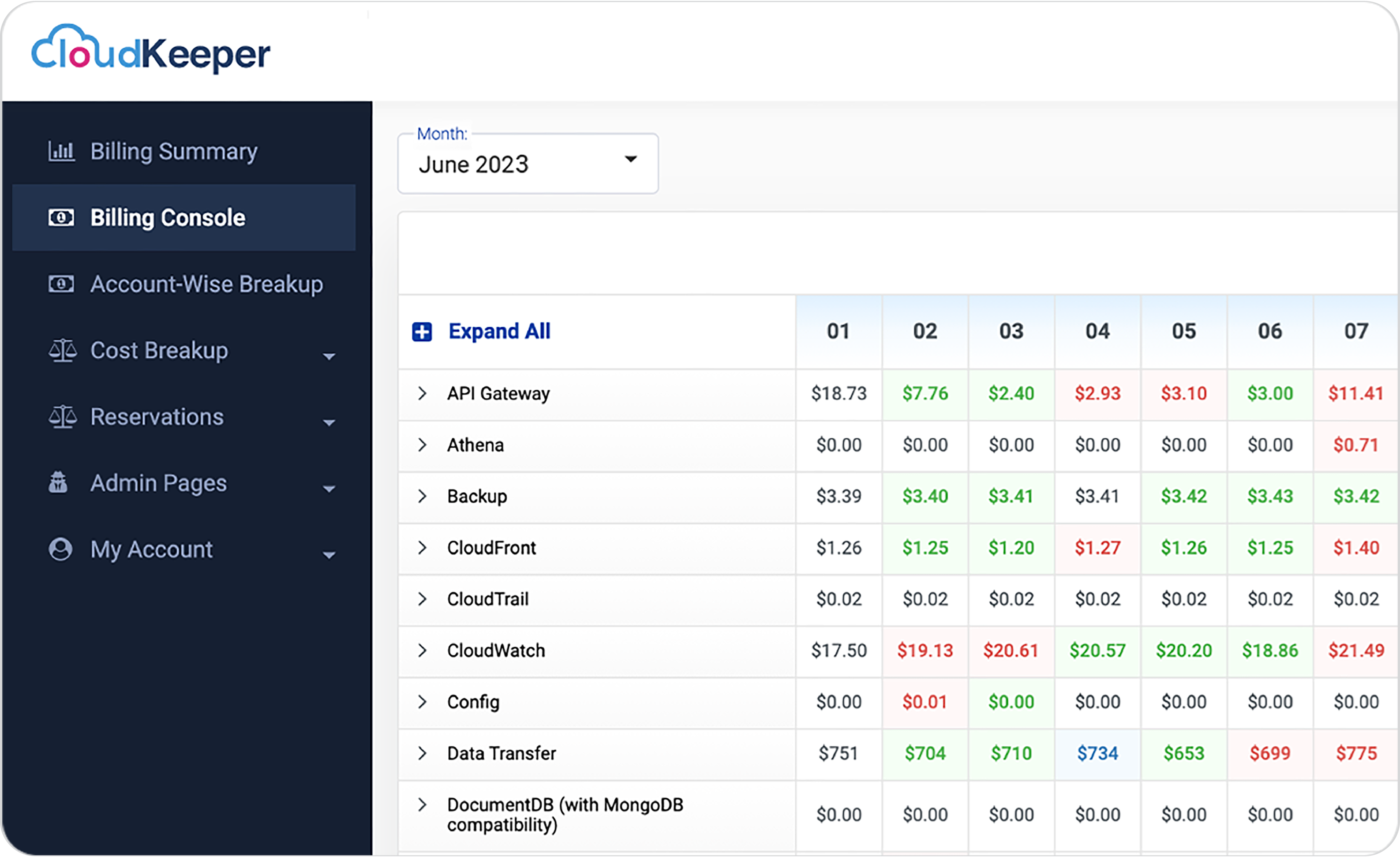The on-demand characteristic of cloud computing allows users to access computing resources (such as storage, processing power, and applications) without upfront investment in infrastructure. While this flexibility is advantageous, it can also lead to unchecked high cloud costs. In an article by Forbes, on average, 30% of cloud spend is wasted. Over two-thirds of avoidable cloud spending stems from idle or underused resources, while nearly six in ten cases result from overprovisioning, resulting in a big deviation from the significant cloud cost savings.
Let’s dig deeper into the cause.
Areas of Overlooked Cloud Expenses- A ready checklist for the Finance team
When it comes to keeping an eye on expenses in the context of cloud cost management, organizations often overlook or underestimate several key areas, leading to unexpected costs. Here are some of the areas that are commonly missed:
1. Unused or underutilized Resources: Failure to monitor and deactivate idle or underused resources, such as instances, storage, or databases, can contribute to a staggering 66% of avoidable cloud spend. Regularly optimizing resource utilization can unlock substantial cloud cost savings by eliminating these wasteful expenses.
2. Data transfer costs: Many cloud service providers charge for data transfer between different services, regions, or external networks. Organizations may overlook these costs, especially when data movement between services or regions increases.
3. Lack of cost allocation: Without proper cost allocation strategies, it can be challenging to attribute expenses accurately across departments, projects, or teams. This can lead to difficulties in understanding where costs are originating, hindering cloud cost optimization efforts.
4. Unplanned scaling and auto-scaling: While auto-scaling can be a powerful tool for handling fluctuating demand, it can also result in unforeseen cloud cost spikes if not configured correctly. Organizations might overlook the costs associated with sudden scaling events, especially during peak usage times. Carefully reviewing auto-scaling parameters and implementing cost controls can yield significant cloud cost savings in this area.
5. Storage costs: Cloud providers charge for storing data, and over time, if not managed properly, these costs can accumulate significantly. Failure to regularly assess and delete unnecessary or obsolete data can lead to inflated storage expenses.
6. Third-Party services and marketplace costs: Integration of third-party services or applications from cloud marketplaces may come with additional costs that organizations might not account for initially.
7. Complex pricing models: Different cloud services often have complex pricing models with various tiers, add-ons, and usage-based charges. Understanding the nuances of these models and accurately predicting costs can be challenging, leading to overspending.
8. Shadow IT or unapproved services: Shadow IT, where employees procure cloud services independently without IT oversight, can be a major security risk and a hidden source of cloud cost leakage. Implementing strong governance policies and monitoring practices can help identify and eliminate these rogue costs, ultimately improving security and cloud cost savings.
9. Compliance and security costs: Meeting compliance standards and ensuring data security in the cloud often involves additional costs for specialized services, certifications, or security measures that organizations might not initially anticipate.

To address these areas and prevent overspending, organizations should implement robust cloud cost management practices. This includes regular monitoring and cloud cost optimization of resources, setting budgets and limits, implementing automated cost controls, utilizing cost-tracking & cloud cost optimization tools, educating staff about cloud cost management, and regularly reviewing expenditures against budgets to identify areas for improvement.
A cloud cost visibility & recommendation platform is a big “YES”
The realm of cloud computing offers vast potential for optimization to achieve cloud cost savings targets, but without a clear understanding of cloud usage patterns, organizations can easily fall into the cycle of overspending. More than half of companies (54%) are losing money on cloud services due to poor visibility into how they're being used and how efficiently they're operating.
A Cloud Cost Visibility and Recommendations Platform, designed for various cloud providers, offers organizations visibility and control over cloud expenses. The platform includes the following features, to ensure businesses have a greater view of their spends:
- Granular cloud usage tracking: It provides a unified view of cloud spending across various cloud providers. This enables tracking expenditure per provider and identifying potential cloud cost-saving opportunities. Users can analyze resource-specific costs, aiding in optimizing cloud spending for better returns.
- Detailed breakdown reports: The reports provide a visual representation of cost variations on a daily basis, allowing users to delve deeper into specific usage types for different cloud services. For example, identifying a surge in Amazon S3 storage usage on a specific day helps pinpoint areas for cloud cost optimization.
- Cloud cost optimization recommendations: This functionality analyzes cloud usage patterns to suggest strategies for optimizing resource utilization, thus allowing organizations to enjoy great cloud cost savings, as per their business infrastructure requirement.
- Notifications: This is one of the highly impactful features that offers concise daily summaries of cloud spending, highlighting breakdowns by provider, service, and resource. Users receive alerts for cost deviations, Reserved Instance (RI) expiry, and utilization.
- RI & savings plan utilization: This feature helps in providing a consolidated view of active/expired reservations for various services. This overview aids in tracking reservations and identifying opportunities for consolidation and cloud cost optimization.
Utilizing such cloud cost analysis platforms empower organizations to gain a clearer understanding of their cloud usage, identify underlying cost factors, and implement effective cloud cost optimization strategies. CloudKeeper Lens is one such cloud cost visibility and recommendations platform, for AWS and Azure services that helps organizations to track, analyze, and optimize the high-cost incurring cloud resources. It is an effective medium to get insights into billing summary, RI & Savings Plan utilization, spend on compute, VM Instances and storage services; all this and more with easy onboarding & no access required to a business's AWS or Azure account.

Leveraging cloud cost visibility tools for greater cloud cost savings
In conclusion, unmasking hidden cloud cost savings demands a comprehensive understanding of cloud usage and a proactive approach to managing expenses. CloudKeeper Lens, among other cloud cost management tools, plays a pivotal role in revealing obscured expenses, thereby empowering organizations to optimize their cloud spending effectively. Organizations must prioritize regular monitoring, rightsizing resources, automating workload management, and fostering a culture of cost consciousness to maximize savings opportunities.
As businesses navigate the ever-evolving cloud landscape, the ability to uncover hidden costs and harness cloud cost efficiencies will undoubtedly be a defining factor in maintaining a competitive edge while ensuring financial prudence in the digital era.
Experience CloudKeeper Lens firsthand by scheduling a demo — sign up now.
